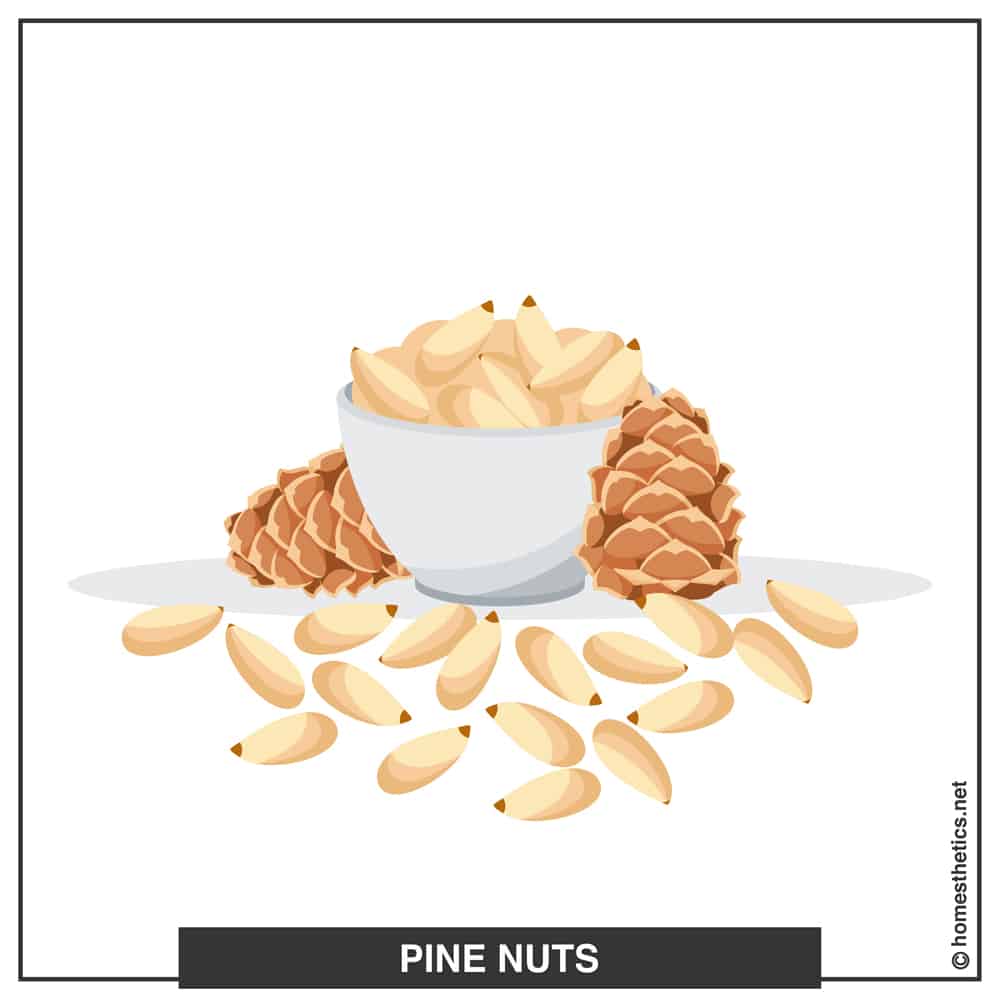Is it too often that you find any food item suggested by fitness trainers being included in a party menu? Surely not!
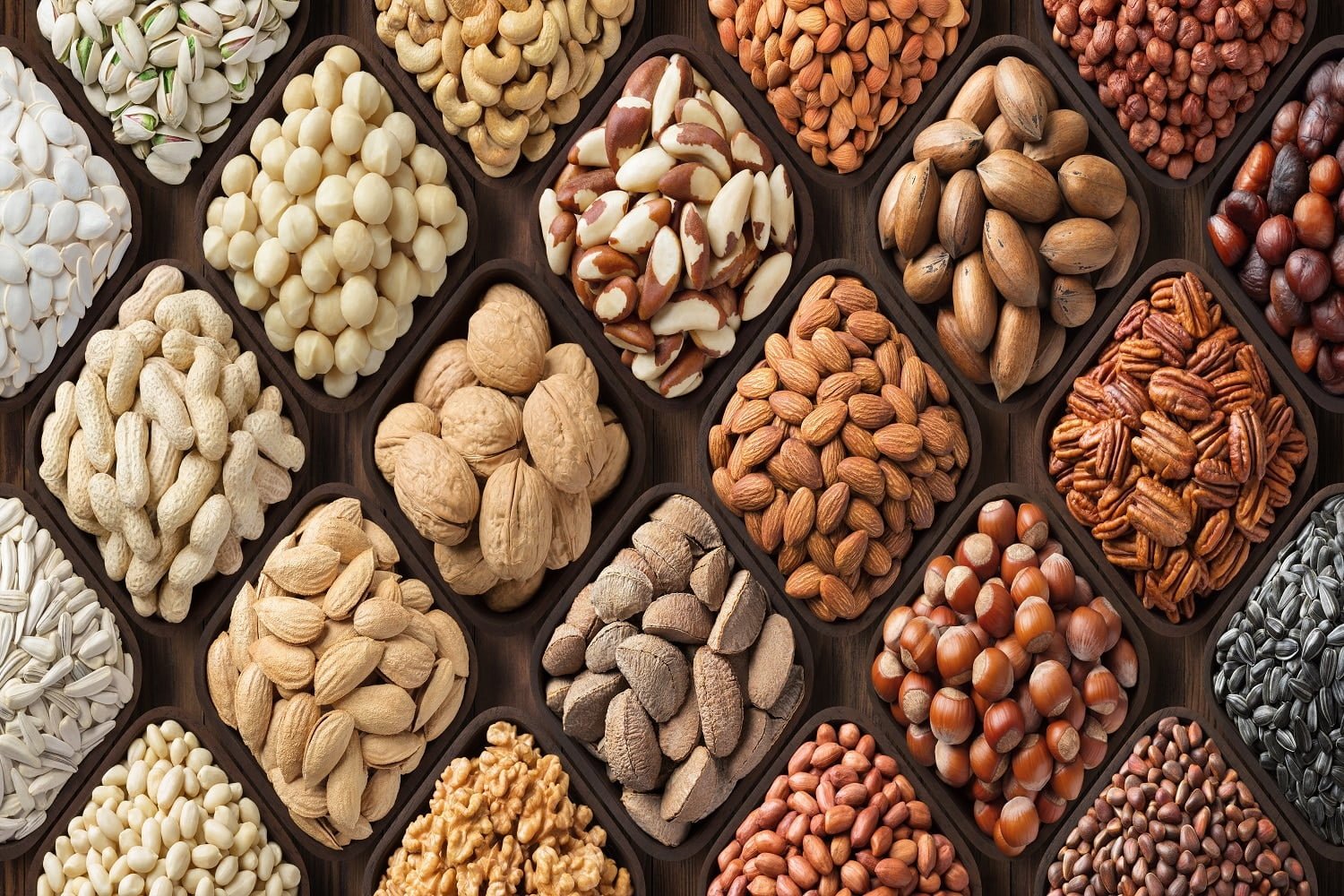
Well, nuts are one of those healthy few, rendering a crunch and flavor that’s key to some of our favorite chicken, pasta, and cookie recipes.
Most of the nuts have the perfect blend of nutrients, allowing you to gain the extra calories needed without having to add flab to the body. There is a multitude of health benefits, depending on the nut that you include in your diet.
In this article, we talk about the 20 different types of nuts, their nutritional benefits as well their use in different food items. You will surely be amazed at how healthy a food choice they can be!
So, read on to know more.
20 Types of Nuts + Benefits & Nutritional Information
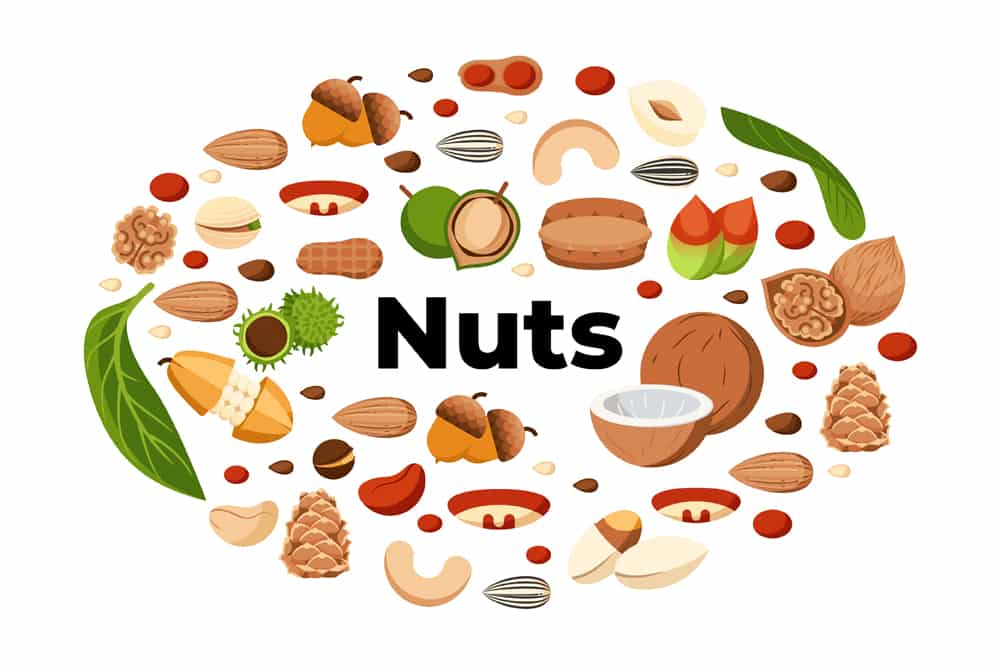
-
Pistachios


This nut is widely grown in western states of the USA and has its origins in parts of Western Asia and the Middle East. Pistachios require desert-like sand to grow and thrive.
Although you can have these in the raw form just after rinsing, many prefer roasting Pistachios for consumption as the taste is enhanced. The nut has higher fiber compared to other varieties and helps improve cholesterol levels. It is significantly helpful in increasing levels of the “good” HDL cholesterol.
Other factors determining the risk of heart diseases such as blood pressure, oxidative status, and weight can also be improved by consuming pistachios. Oxidative status indicates the blood levels of oxidized chemicals that can contribute to heart diseases.
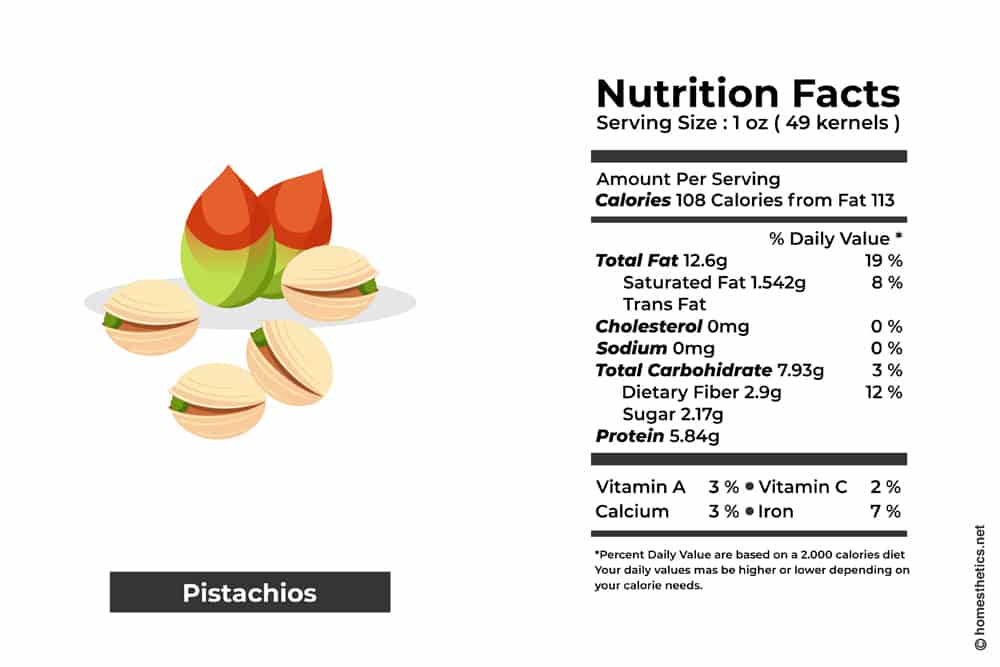
California pistachios are the dominant variety in the domestic market, but it’s great if you can get hold of the Turkish and Persian varieties. The latter has a darker shell and skin and is much more flavorful. Pistachios can be used in famous delicacies such as kulfi, spumoni, pistachio ice cream, and baklava.
-
Walnuts


A favorite ingredient of all the bakers out there, this is one of the few nuts available through all seasons. Walnuts are grown in many countries across the world, including Iran, the USA, Turkey, China, and Mexico.
The stone fruits growing on large trees can be shelled and eaten in raw, roasted, as well as seasoned forms. Before consumption, you just need to make sure they are thoroughly washed and dried.
Walnuts contain high amounts of antioxidants and alpha-linolenic acid (ALA), an omega-3 fatty acid. The high ALA content helps to reduce the risk of heart ailments and also reduces LDL or bad cholesterol levels. They also maintain proper blood flow through the circulatory system.
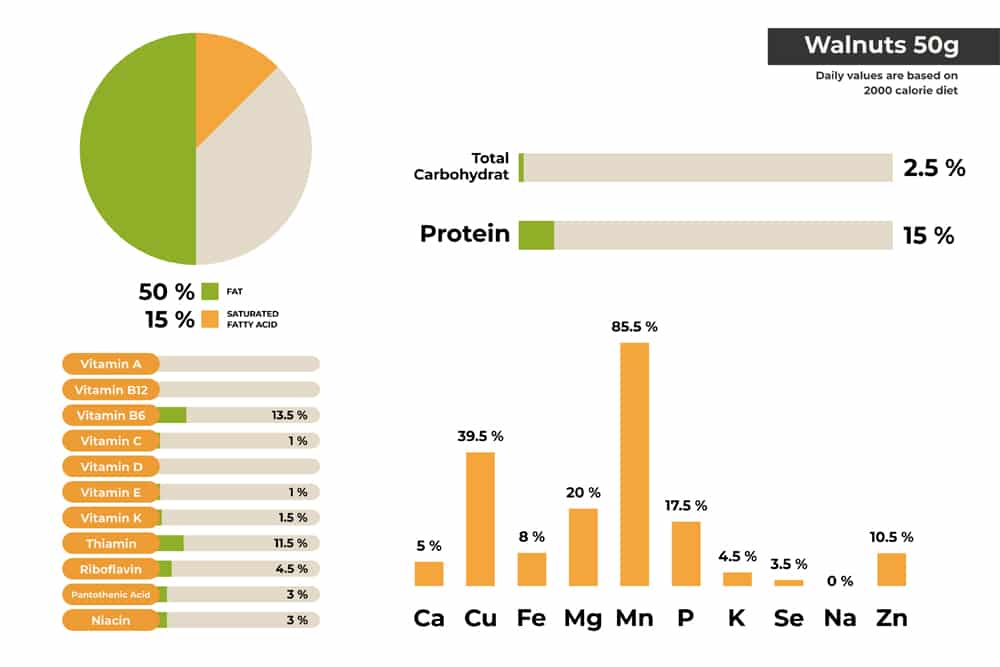
Interestingly, a study conducted on college students has found that walnuts have beneficial effects on the brain by improving the power of perception.
Besides being a popular garnish for sweet dishes, walnuts are also used to make desserts such as brownies and khoresht, a traditional Iranian delicacy.
-
Almonds
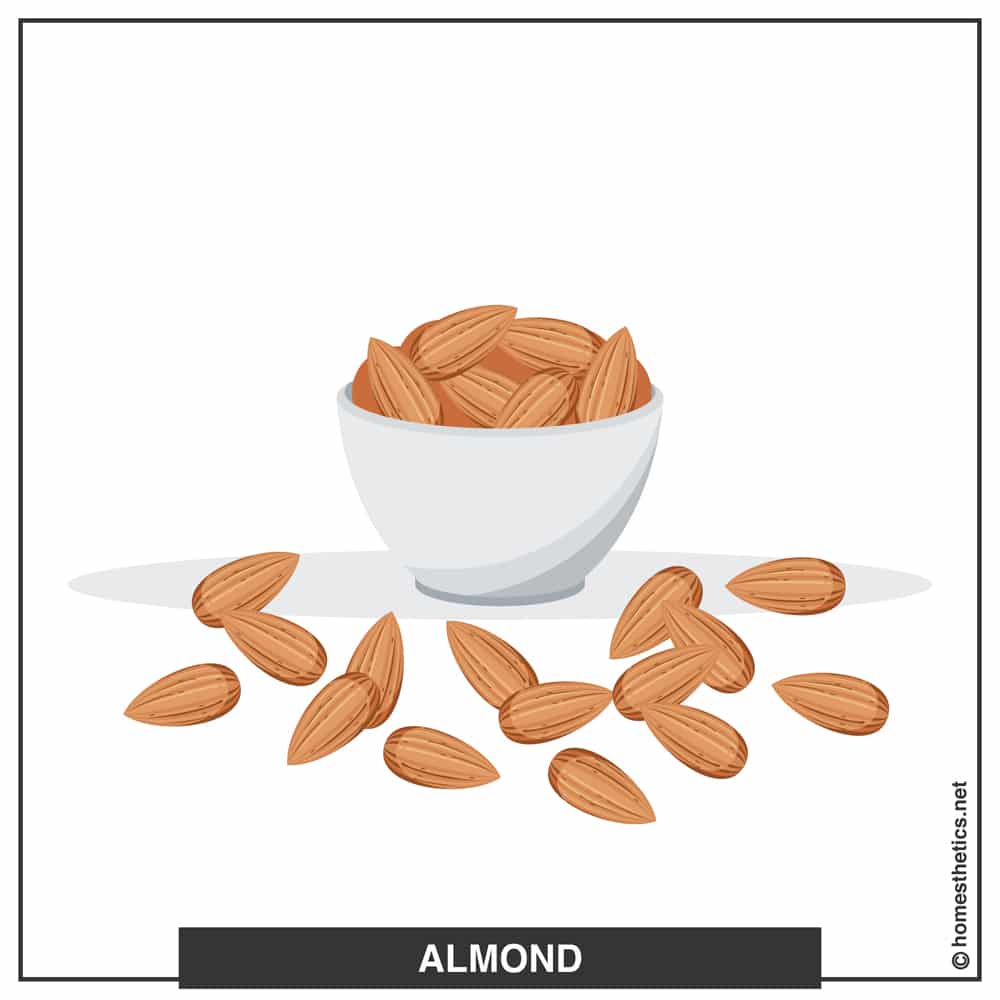
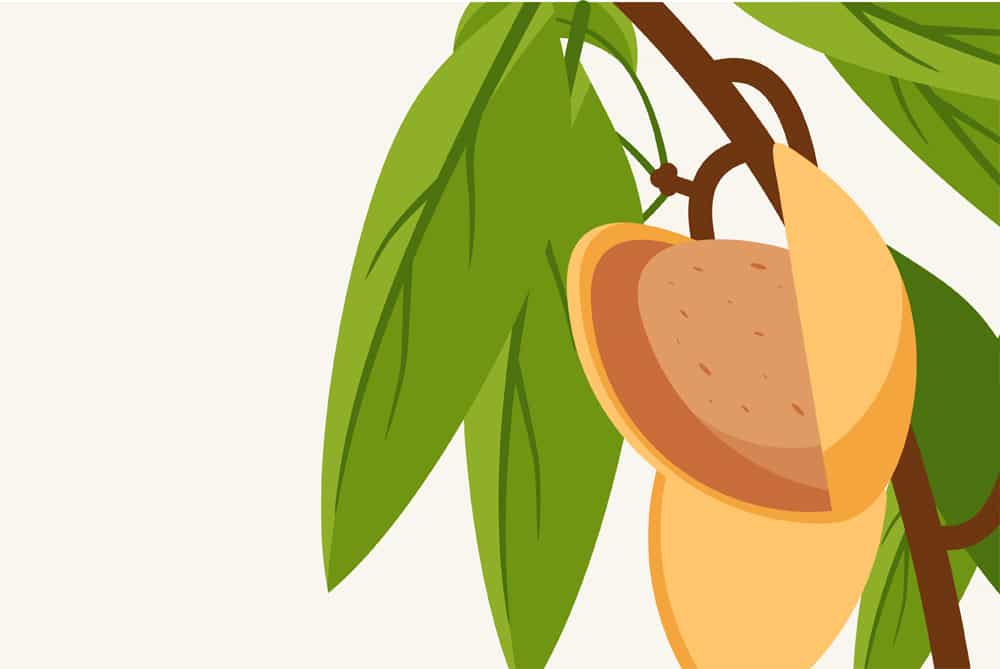
While a majority of these nuts are grown in California, they are also found in Spain and Italy. Almonds can be consumed fresh from the tree, but drying them out for at least two weeks ensures they have the maximum flavor. Unlike some other nuts, they are sold in whole, slivered as well as sliced forms.
As for the nutritional value of almonds, they are rich in monounsaturated fats, vitamins, proteins, and minerals. Maintaining an almond-rich diet has been found to reduce levels of harmful cholesterol in the body, which is integral to heart health.
Added to this, almonds also aid weight loss and lower the blood pressure of those suffering from obesity. They have also been found to reduce inflammation in type-2 diabetes patients.
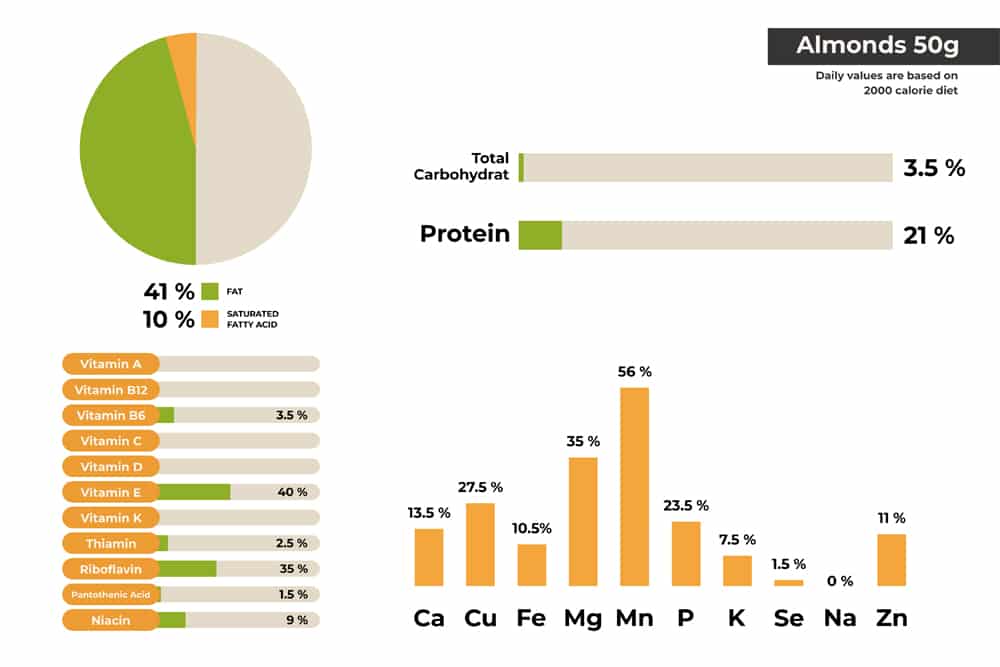
The mildly sweet flavor of almonds is loved by many, which is why they are used in several dishes such as almond-crusted chicken, salads, and cereal meals. This flavor is magnified to prepare several by-products such as almond extracts, marzipan, and almond paste.
-
Cashews
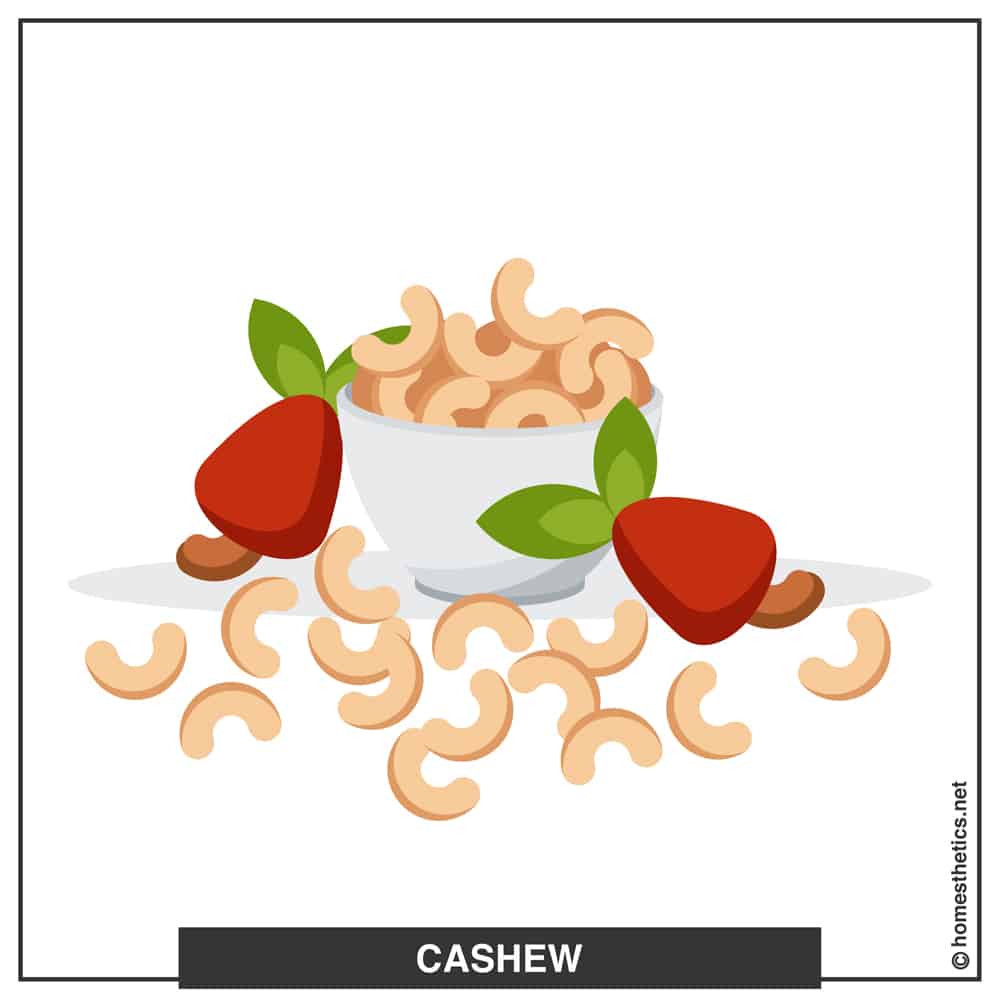
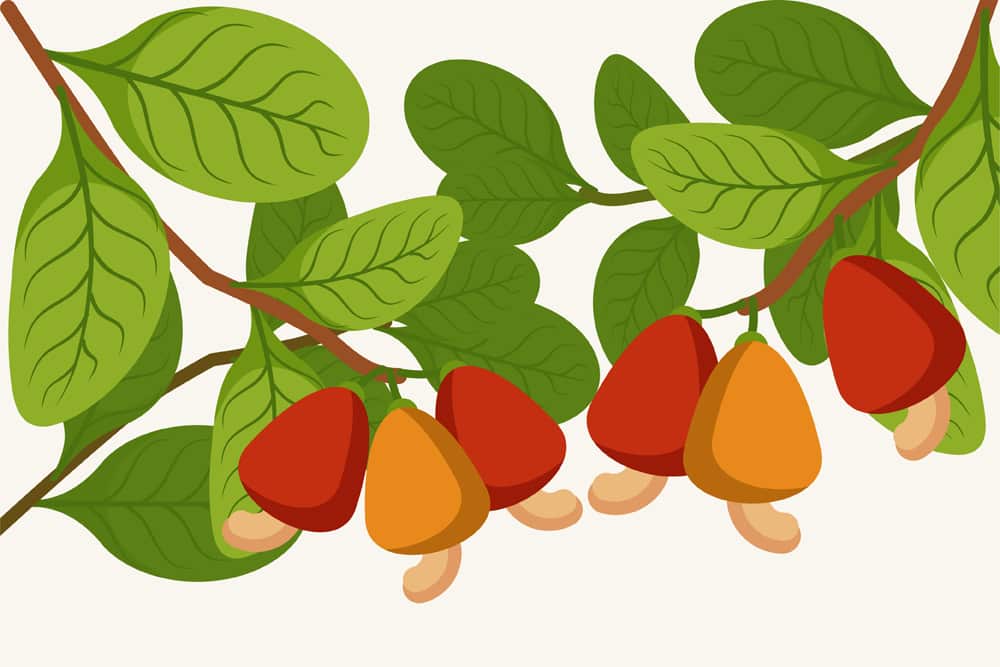
Having an almost neutral flavor, the popular South American nuts add shape, crunch, and texture to any recipe. They made their way to Indian and Thai cuisines several centuries ago through Portuguese explorers.
At present, Cashews are grown in a number of wet and dry tropical regions, including Vietnam, Africa, and Southeast Asia. To be made fit for consumption, the outermost shell of cashews must be removed. The shell contains a caustic liquid which may cause severe skin burns.
Cashews have a lot of uses due to their immense value as an antioxidant. Hence, when added to any diet, they increase its antioxidant potential. They are also highly rich in magnesium, which helps in improving joint flexibility. For people suffering from metabolic syndrome, cashews improve blood pressure.
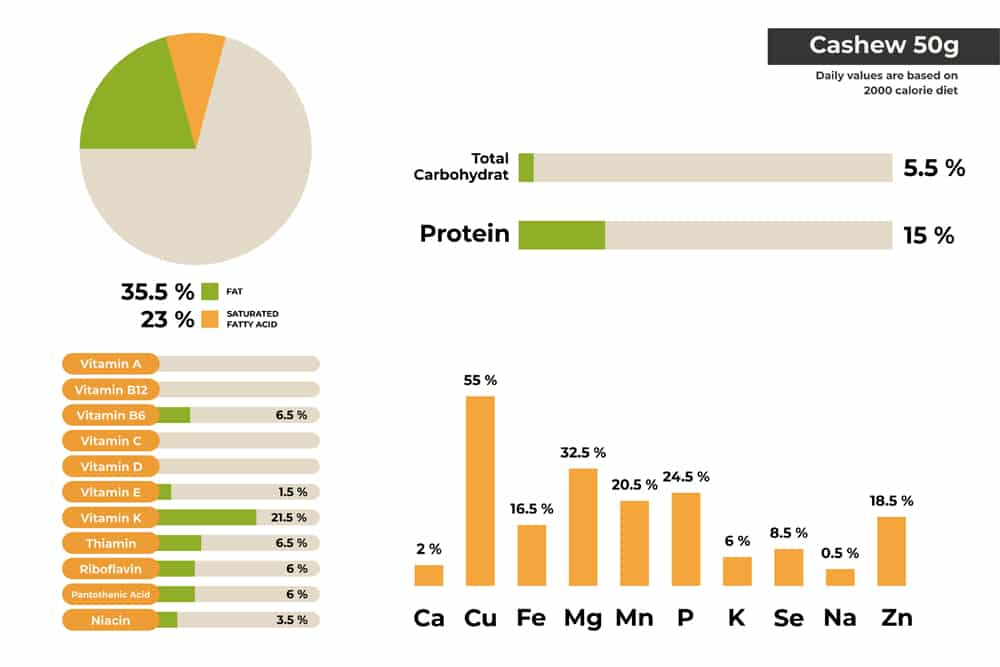
Besides, cashews constitute an extremely important ingredient in savored delicacies from around the world. They are used in dishes such as cashew chicken and stir-fry, chicken salad, and chocolatey desserts. Cashew milk is also a quite popular nutritious alternative to dairy.
-
Hazelnuts
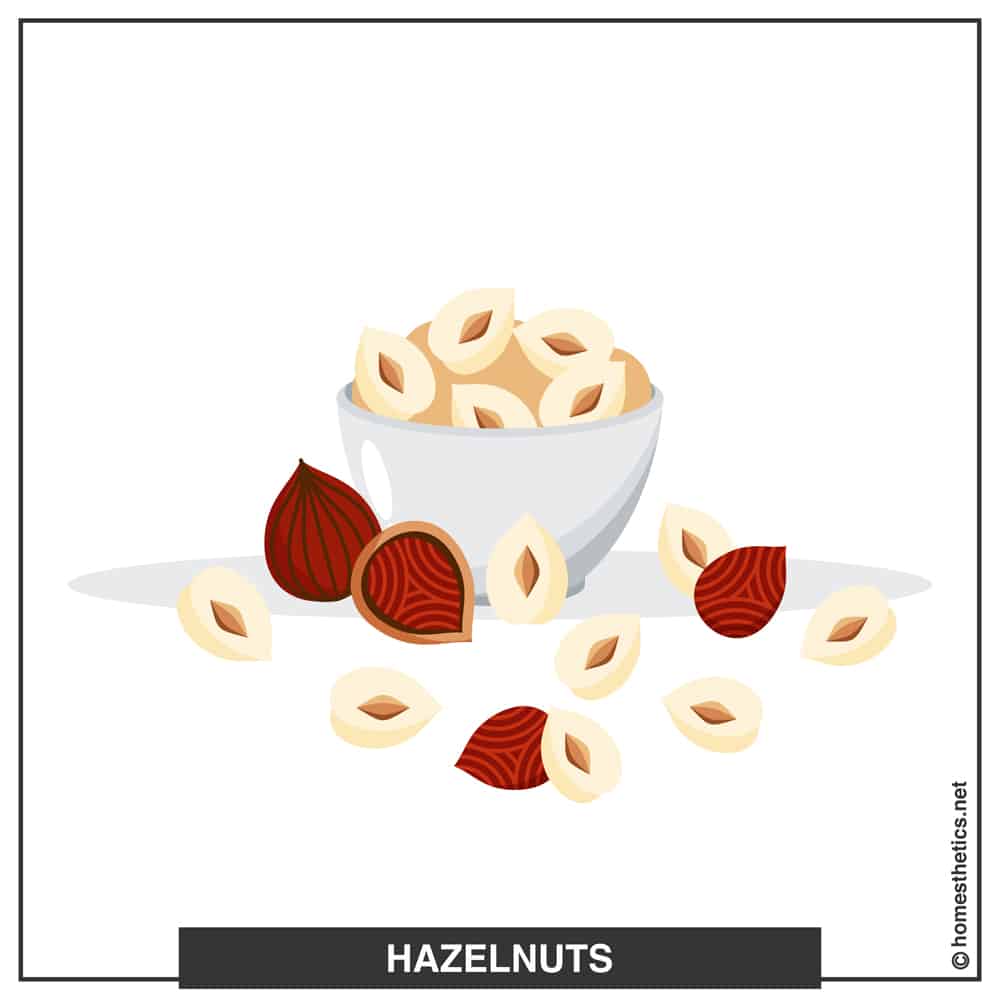
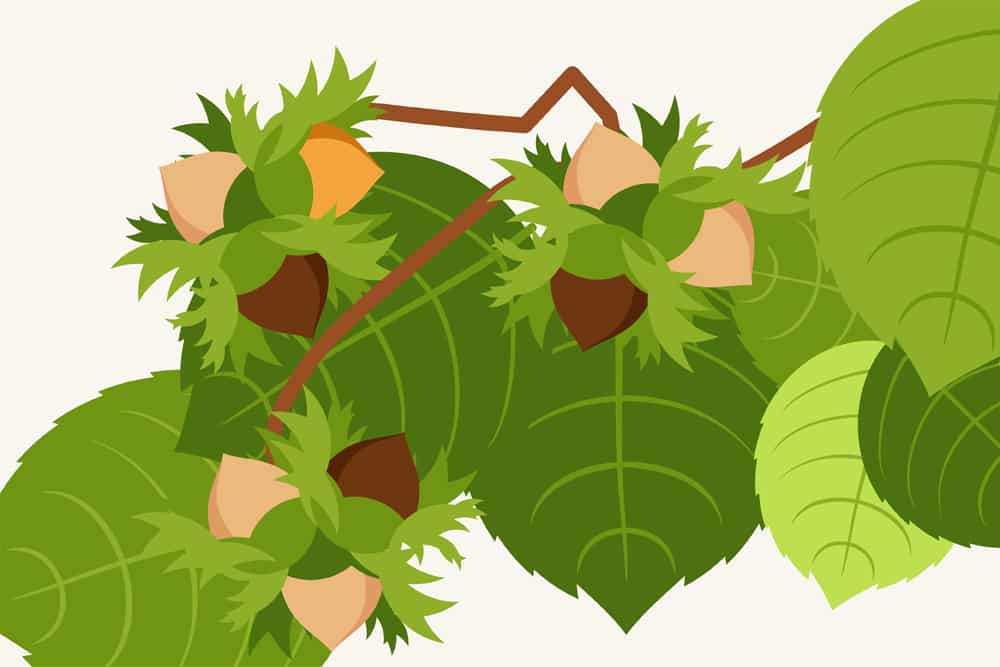
The round-shaped nut is a primary ingredient of the commercially available Nutella, a universal favorite. Their pairing with chocolates in this world-famous spread gives a taste that is no less than heavenly!
Hazelnuts are commonly grown in several regions of North America, Europe, and Asia. They need to be dried out within 24 hours after picking and should be shelled before consumption.
The nuts can be eaten in raw form, but roasting helps to enhance their flavor and also increases their crunchiness. This way, they can also lend a great texture when used in salads and soups. Besides this, hazelnuts are also commonly used for flavoring coffee.
Although nuts have a lesser protein content, other essential nutrients make them extremely beneficial for health. Some of these include vitamins, monounsaturated oil, and minerals. Similar to other types of nuts, they also help in alleviating risk factors of heart diseases.
-
Brazil Nuts


As the name suggests, this giant nut is native to Brazil and can be spotted throughout the rainforests of the Amazon. The nut can either be eaten in raw or blanched form. But it has an extremely hard shell that must be cracked before consumption.
Importantly, these nuts are storehouses of vitamins, including calcium, iron, niacin, and the antioxidants vitamin E and selenium. Small quantities of these antioxidants are essential in an ideal diet. You can fulfill this requirement easily by consuming around 28 grams of these nuts daily.
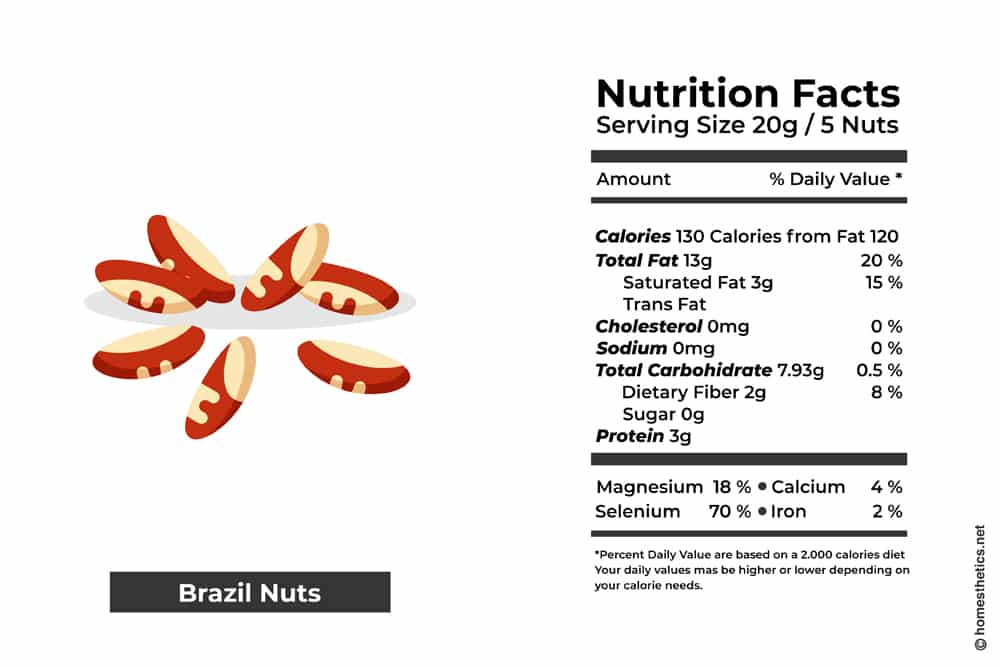
Besides these benefits, brazil nuts also help to reduce the level of cholesterol in the body and improve the functioning of blood vessels. The nuts even assist in reducing inflammation in both healthy people and those who are undergoing hemodialysis.
You can add this nut to a variety of dishes such as macaroons, cookies, and salads. Brazilians add this nut to lend a different flavor to their milk and cheese.
-
Pecans
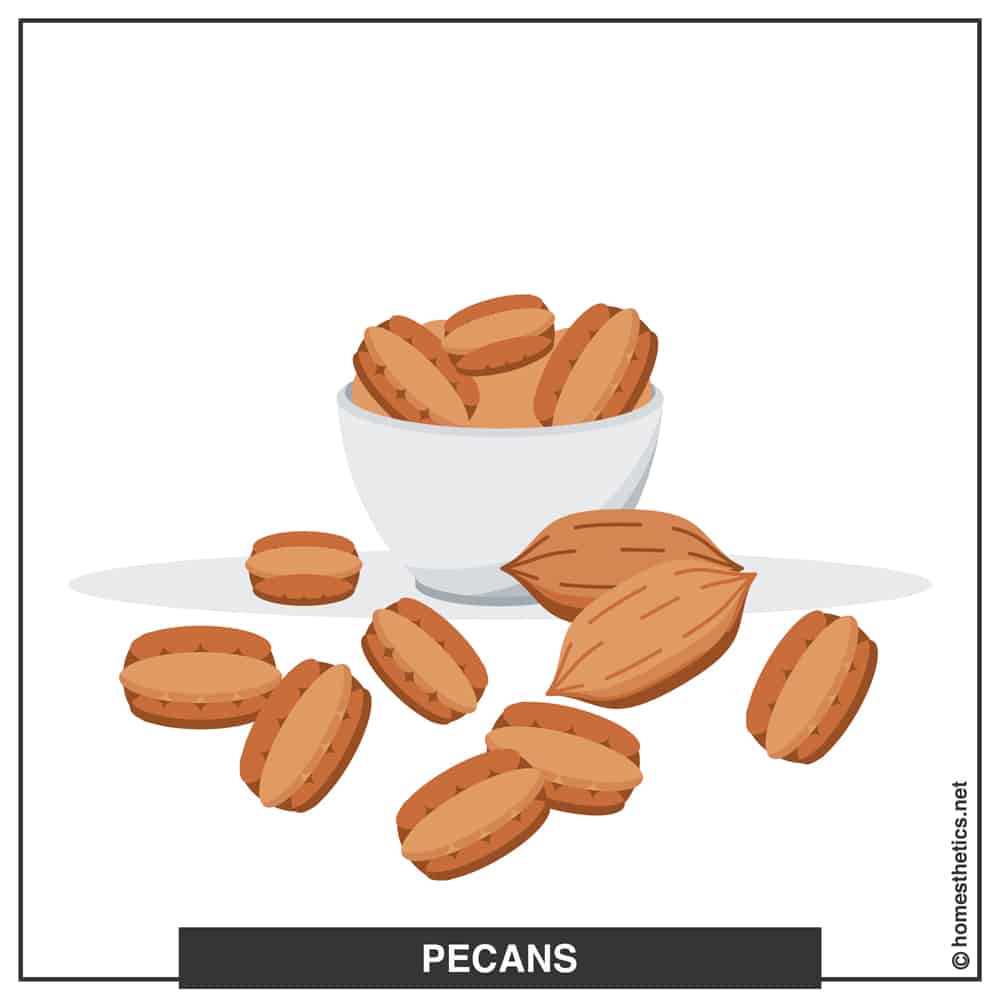

Native to the continent of North America, pecans have a characteristic sweet flavor that makes them an ideal ingredient for cakes. They are a tree-fruit and are frequently found in orchards and groves throughout the USA.
The nuts must be dried for a minimum of two weeks within their shells to get the right taste and flavor. Although many people also prefer to consume the nuts after shelling and roasting. Even for adding them as an ingredient other than while baking, it is best to use the roasted form.
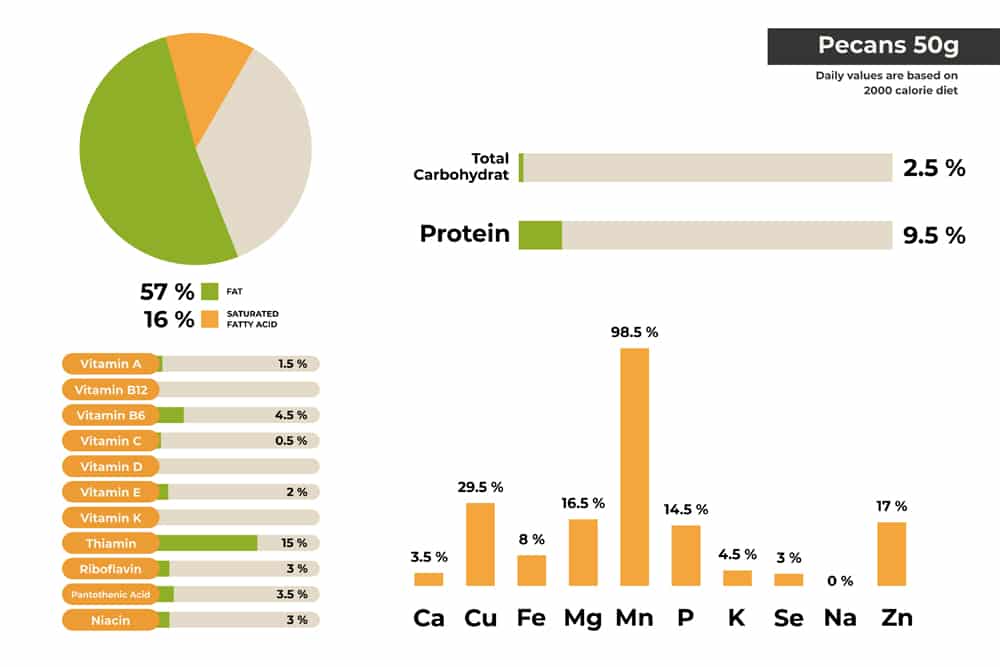
Containing as many as 43 different nutrients, pecans are a quite healthy option to include in your diet. Studies have shown they can lower the “bad” LDL cholesterol in people who have normal cholesterol levels. Moreover, regular consumption of pecans also improves the antioxidant profiles in the blood.
A hugely popular dish made using pecans is a pecan pie. The nuts are also used in other delicacies like candied pecans, chicken salad, and chocolate turtle candies.
-
Macadamia Nuts

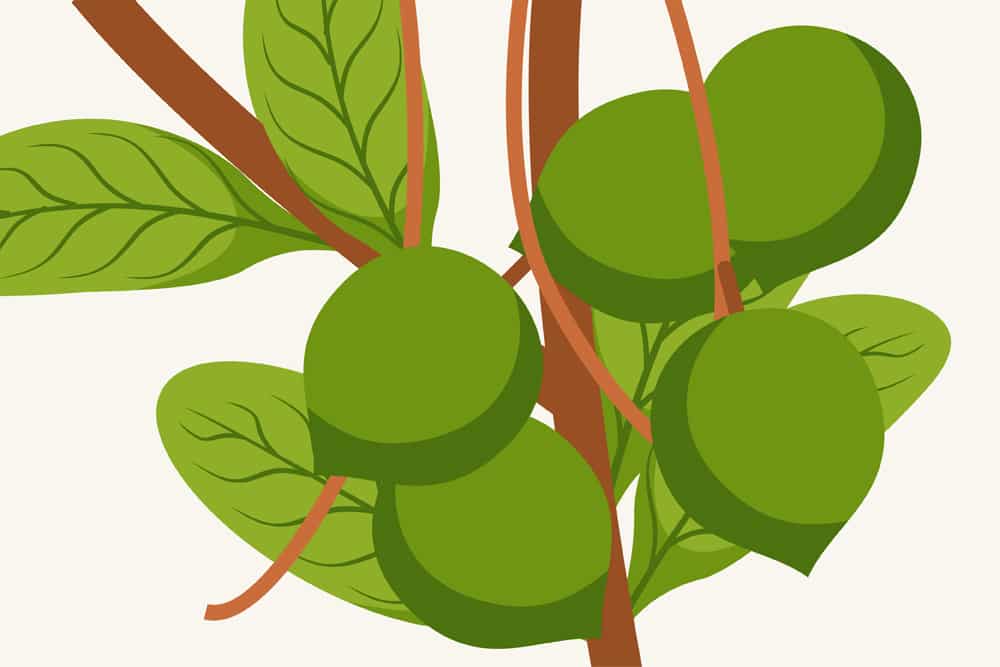
Mainly grown in Australia and Hawaii, these large nuts are quite a palpable option to include in the diet. Currently, they can also be found in several regions of the continents of Latin America, Asia, and Africa.
The nearly buttery flavor gives a unique taste to macadamia nuts. They grow in large and bushy trees that might take as long as 5 years to start bearing fruits. Ideally, they should be shelled within 24 hours after picking.
Macadamia nuts have a wide variety of nutrients in them. Primarily, they are an excellent source of monounsaturated fat, vitamin A, iron and protein. A diet rich in these nuts has been shown to produce effects similar to a heart-healthy diet advised by the American Heart Association.
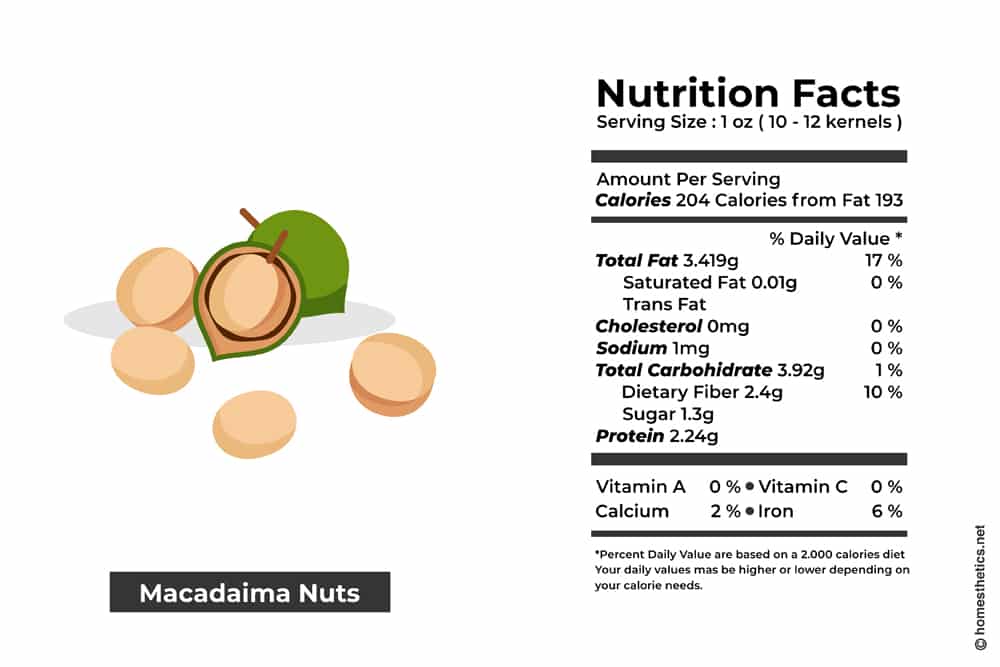
Macadamia nut cookies are a favorite among people with a sweet tooth. The nuts are also used to prepare other palpable desserts such as muffins, granola, and fudge. Moreover, when chopped up, these nuts go really well with fish as well as chicken.
-
Peanuts

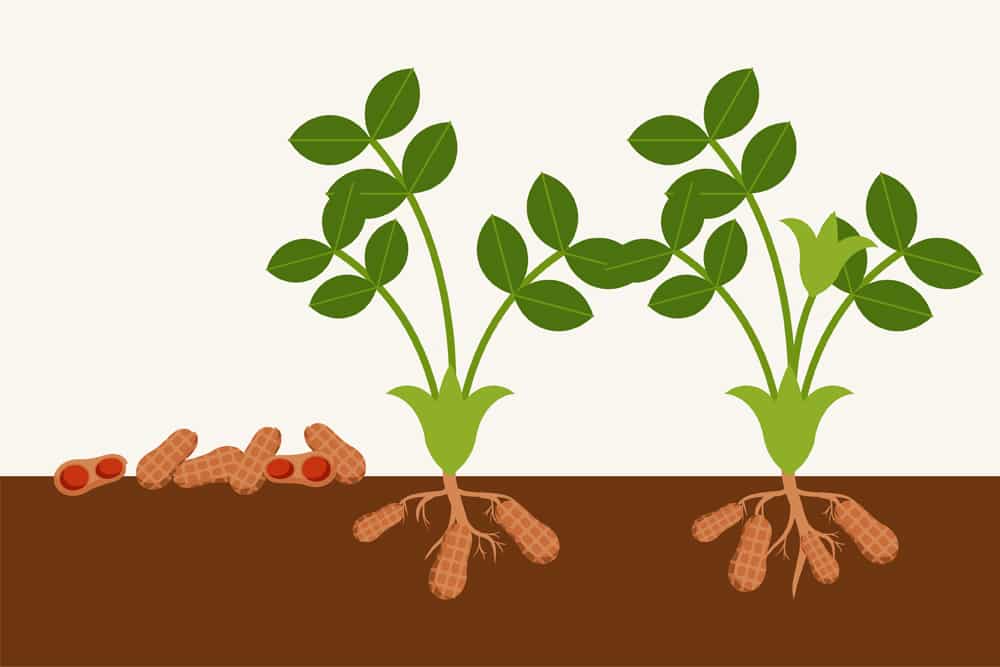
Technically, peanuts are legumes like beans and peas, but they are considered to be nuts due to their culinary usage. They are quite affordable and have a year-round availability, making them popular among people worldwide.
Many of you may not know that peanut grows under the soil, though the plant flowers are above the ground. They should be shelled during harvesting and are fit for consumption after thorough rinsing and drying in the sun. Although, some people also prefer roasting peanuts to maximize the earthy flavor that they possess.
Interestingly, peanuts are a rich source of plant-based protein, making them an ideal component of a weight loss diet. The protein content also alleviates the risk of heart disease. Moreover, the consumption of peanuts by mothers during pregnancy has been found to lower rates of asthma and allergic diseases in children.

The “nuts” are most popularly used to make peanut butter, a favorite of people from across the world. Apart from this, they are used in their whole form in baked products, granola, and trail mix.
-
Pine Nuts
Produced in several regions of Europe, North America and Korea, the small beige-colored nuts grow in multiple species of pine trees. The taste and shape of the nuts might vary a little depending upon the species of pine. For example, the Italian pine nuts are more slender than their Chinese counterpart.
For consumption, pine nuts are normally dried out and then roasted. Although, many of you may also like them as a snack in the raw form for the characteristic buttery taste.
Pine nuts are rich in the trace mineral manganese, which helps in carbohydrate metabolism and maintains the proper blood sugar level. Studies have shown that fatty acids present in the nuts also help to boost satiety hormones.
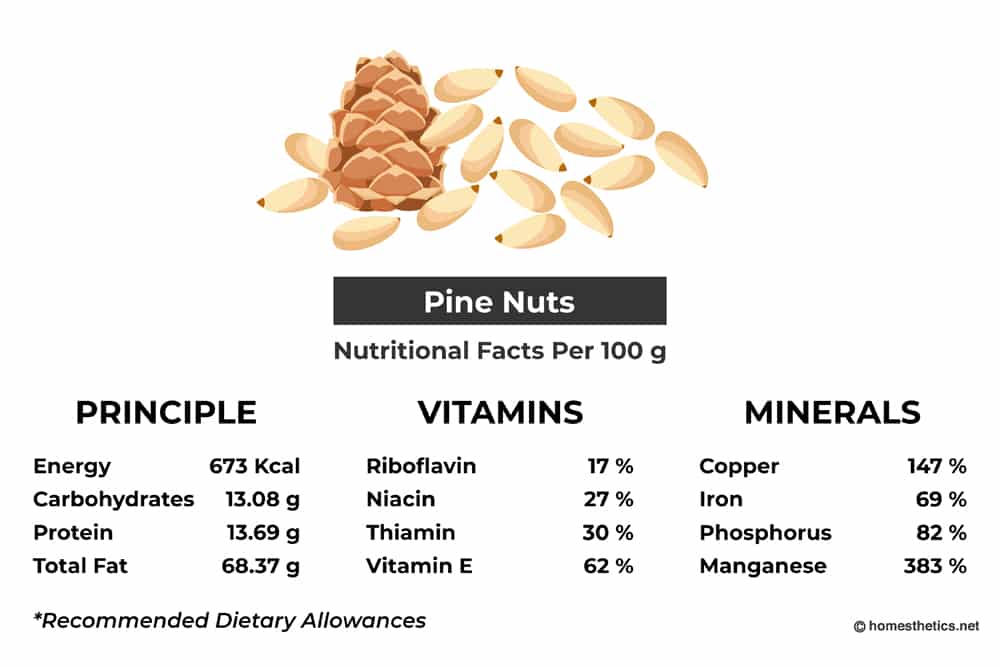
The nuts can be added as an accent to several fish and meat recipes, salads, and baked bread varieties. The mild flavor of pines along with a soft chewy texture is loved by many when incorporated into any dish.
-
Chestnuts
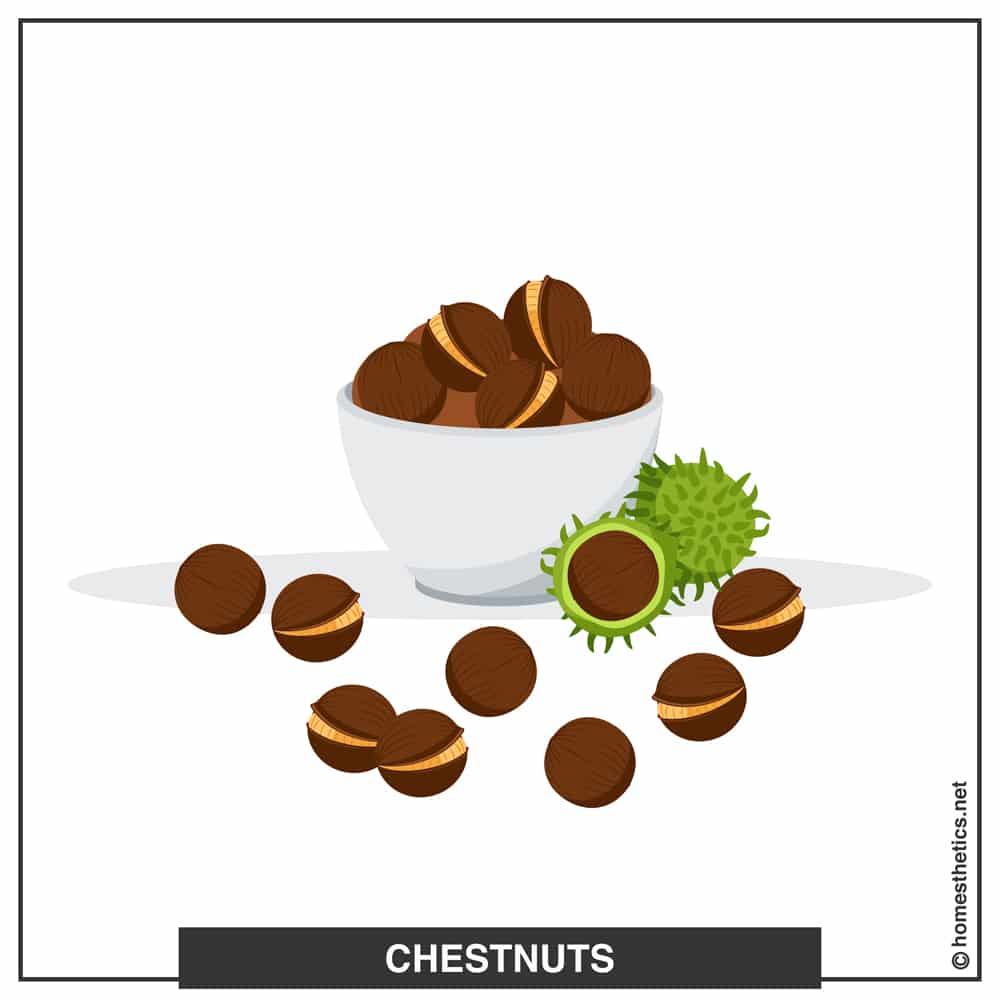
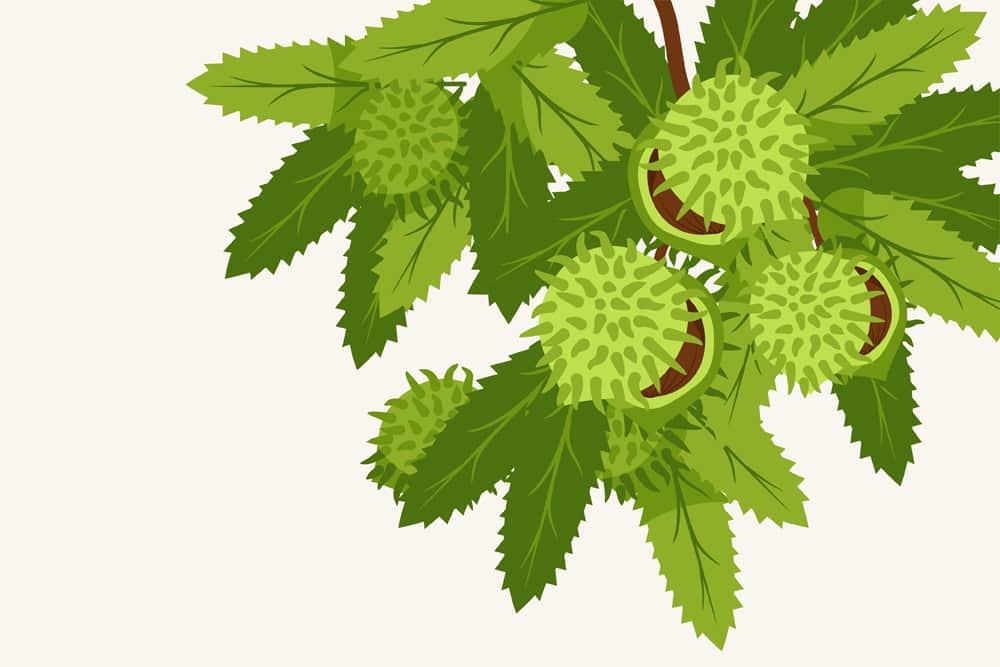
Growing on trees or shrubs, chestnuts are found mainly in China, South Korea, Greece, the United States, and South America.
These nuts can be eaten raw just after peeling them, but are rather bland in this form. It is best to consume them after storage in the refrigerator for a few days, as the starch changes to sugar.
Importantly, chestnuts are rich in carbohydrates, as opposed to other types that contain oils. They also contain amides and a number of vitamins such as folic acid and Vitamin B that help in fighting anemia.
The nuts have also been found to help in digestion. Apart from this, minerals such as magnesium and potassium help in reducing risk of cardiovascular diseases as well.
Chestnuts also attain an appealing taste when they are candied, steamed, deep-fried, or grilled. They are used in desserts such as pies and cakes, but can even act as a thickener for any soup or sauce.
-
Cedar Nuts
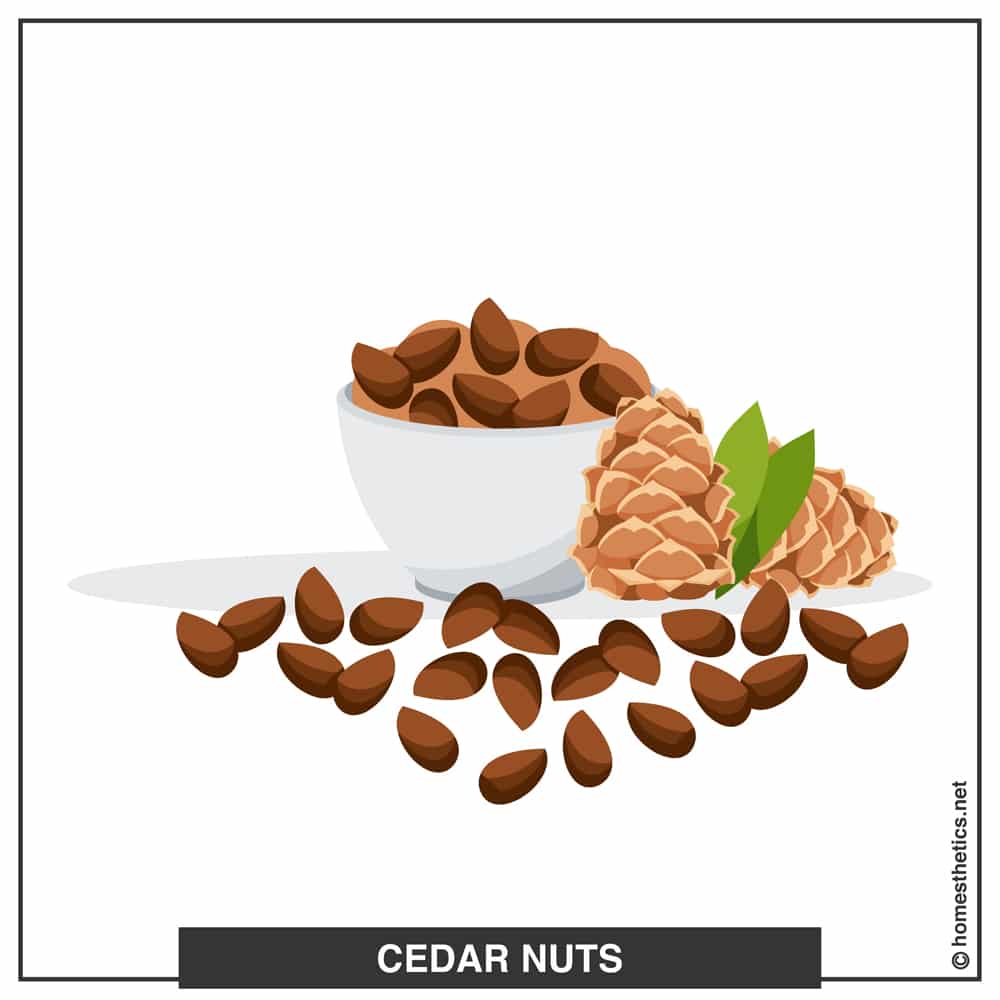
Obtained from the cedar pine trees of Siberia and East Russia, these crunchy nuts are a variety of pine nuts. Cedar nuts can be eaten in the raw as well as roasted form. Being a rare variety, many people are aware that the tasty seeds of the cedar cone have great health benefits.
These nuts are known for their ability to facilitate weight management. Studies have shown that cedar nuts are effective in suppressing a person’s appetite. Pinolenic acid present in these nuts stimulates a hormone that sends signals to the brain that the stomach is full.
Apart from this, cedar nuts are rich in beta-carotene, which helps to maintain eye health. Lutein present in the nuts also prevents the eyesight from deteriorating with age. Antioxidants in them destroy free radicals that encourage the development of terminal diseases such as cancer.
These nuts are generally eaten in plain form but can be added to savory beef recipes and salads to enhance the taste and flavor.
-
Coconut


This might be hard to believe, but coconut is indeed classified as a nut as well as a fruit! The tropical nuts with a fat hard shells are produced by palm trees. These trees grow in several tropical regions around the world, including South and Central America, the Caribbean, and India.
These nuts can be eaten in their raw form after shelling or can also be added as an ingredient to several dishes. The bare white portion inside each coconut, called the kernel, has the perfect balance of sweetness and texture.
This incredible taste along with a number of health benefits makes coconuts a universal favorite. The minerals present in coconuts help in maintaining bone health and nutrient metabolism. Also, the high fiber content and low carbs in coconut help to stabilize blood sugar.
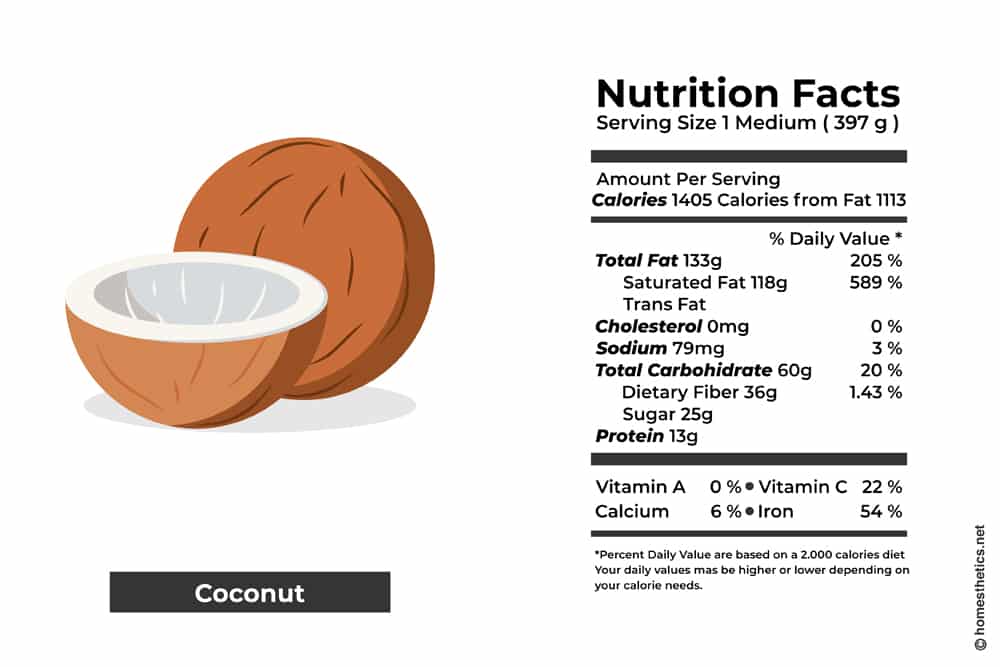
Apart from the delicious taste and health benefits of the kernel, consumption of the oil extracted from the nut also helps in reducing belly fat. The dried kernel is generally chopped or grated to add that special coconut flavor while cooking.
-
Marcona Almonds
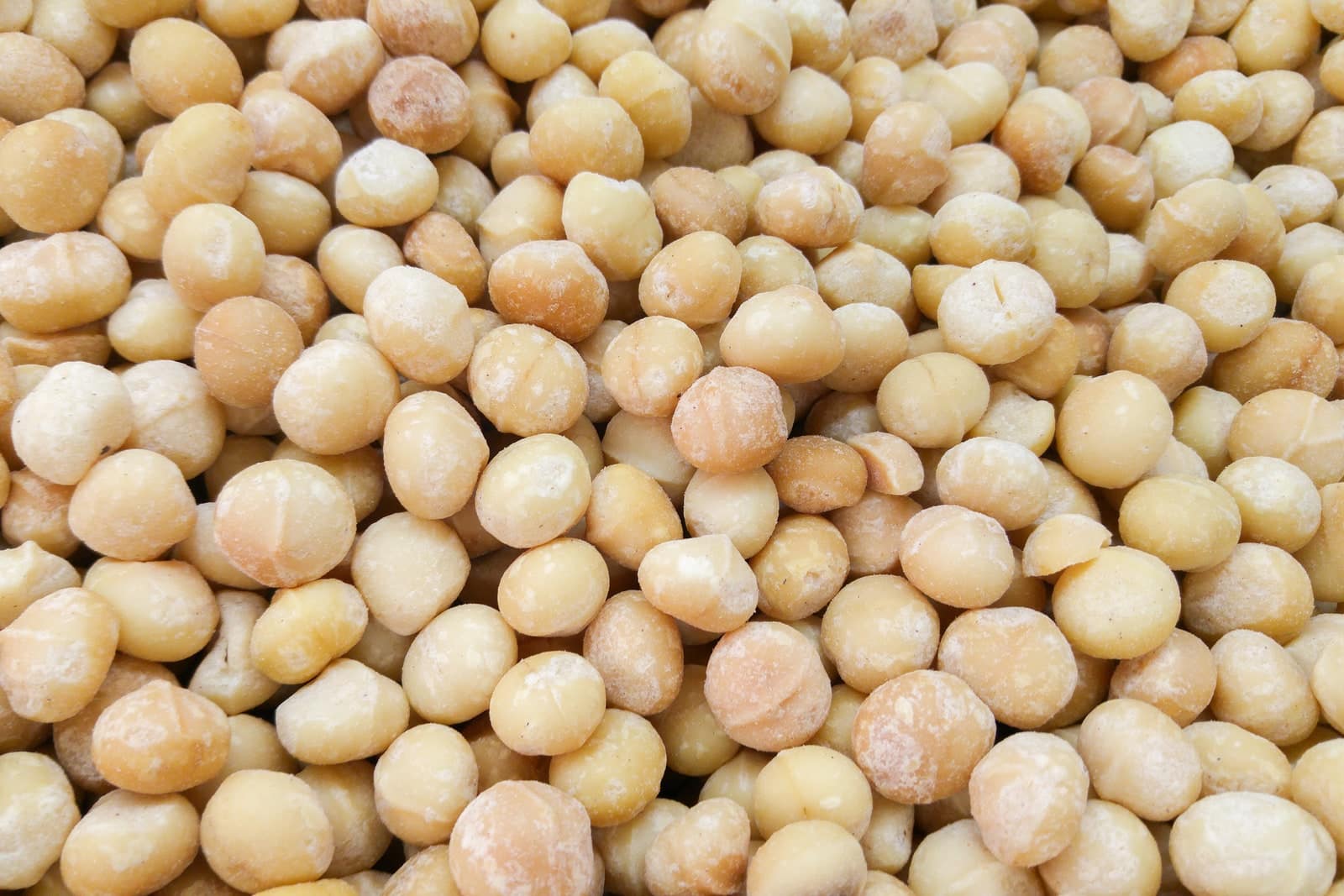
Having origins in Spain, Marcona almonds are much flatter, rounder, and sweeter than the classic buttery variety. The delicate aroma and taste of this variety are akin to the almond essence used in bakery products.
These almonds are generally sold in a pre-cooked form- by frying or roasting and then salting them. They make for a great snack in this version.
Their appealing mouthfeel and unique taste can turn an ordinary dish to a special one. This is why they have also won the hearts of chefs and gourmands from across the world. The variety can be sauteed in oil and sprinkled over a salad or can be chopped and added to baked goods.
Coming to the health benefits, this variety of almonds contains higher amounts of monounsaturated fats, which is a key to proper weight management. It also contains vitamins and minerals in high amounts, which help to maintain cardiovascular health.
-
Flaxseeds
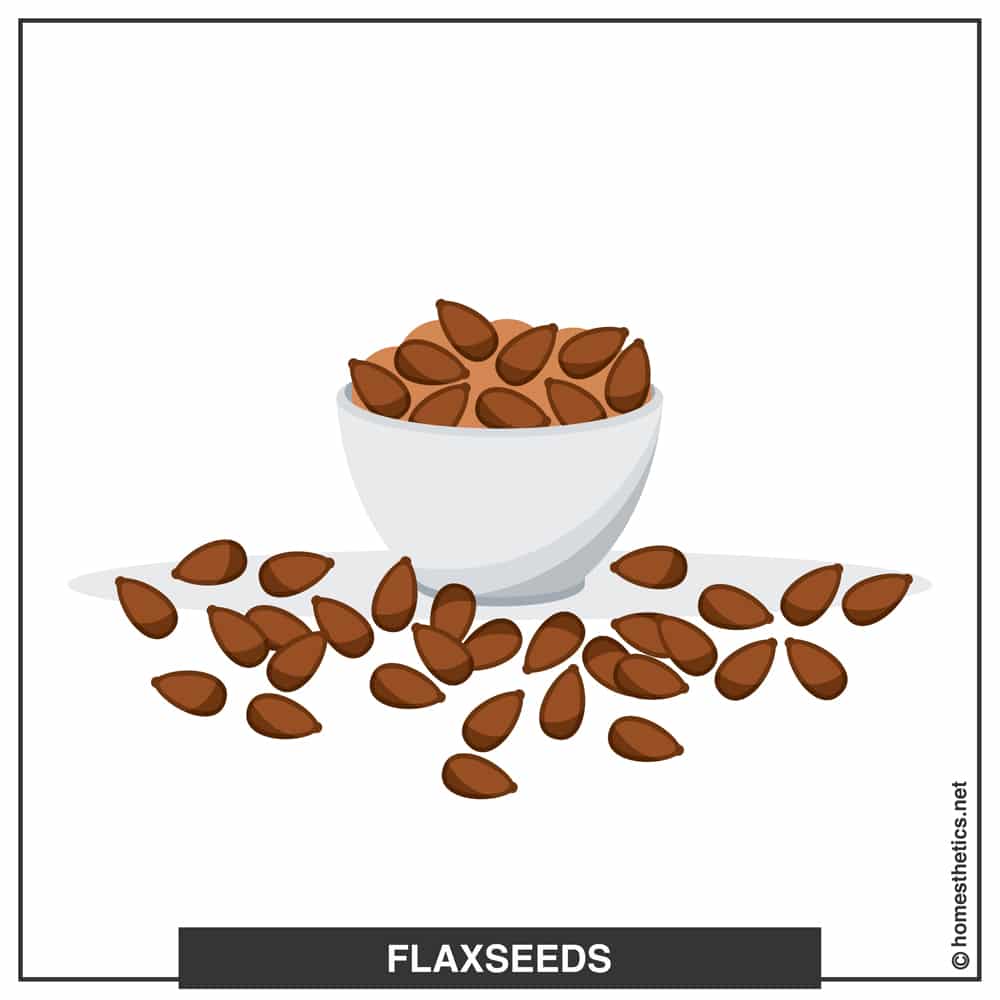

Commonly found in Canada, Europe, and Russia, flaxseeds have several health benefits and are obtained from a flowering plant around 2 feet tall.
But before they can be fit for consumption, flaxseeds must be rinsed thoroughly and dried. You can surely eat them raw and whole, but they are easily digestible when ground up.
Flax seeds are emerging as a superfood, as scientific studies have pointed to their wide range of health benefits. Just a tablespoon of flax seeds can provide you with a substantial amount of protein, amoeba-3 fatty acids, and fiber. Moreover, they are rich sources of important vitamins and minerals.
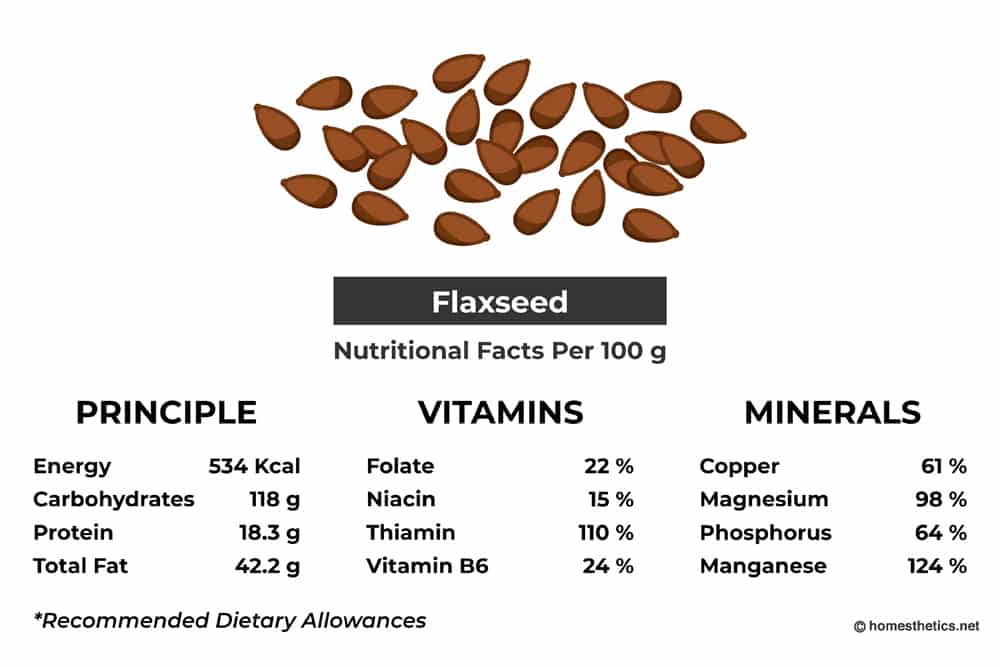
Flaxseeds can act as an exciting dressing on salads of all kinds and can also be added into cooking, muffins and bread. They can even be sprinkled on cereal meals for breakfast. All in all, having flax seeds in your meal makes it tasty and healthy at the same time.
-
Kola Nuts

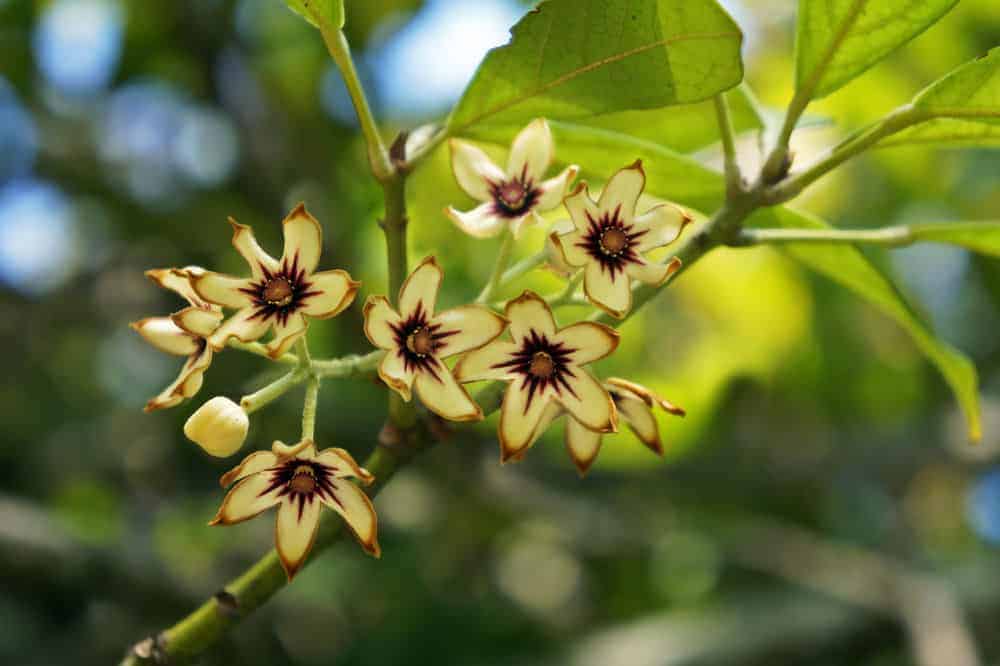
Coming from the Kola tree native to the rainforest climate in Africa, the nuts are enclosed in white shells inside the tree’s star-shaped fruits. The nuts taste bitter in the mouth initially but become sweeter with chewing.
Interestingly, these large nuts are an important cultural symbol for ethnic groups in African countries. They are given to guests during weddings, naming ceremonies, and funerals. Members of such ethnic groups also use nuts as a medicine due to their beneficial properties.
Kola nuts are rich in caffeine, which boosts metabolism and improves blood circulation. Caffeine is also well-known for boosting energy levels. Studies have shown that the extract of this nut has antibacterial properties.
Due to their caffeine content, Kola nuts are widely used as flavoring agents in beverages. Due to its flavor, the raw nut is also frequently chewed in West African cultures.
-
Acorns
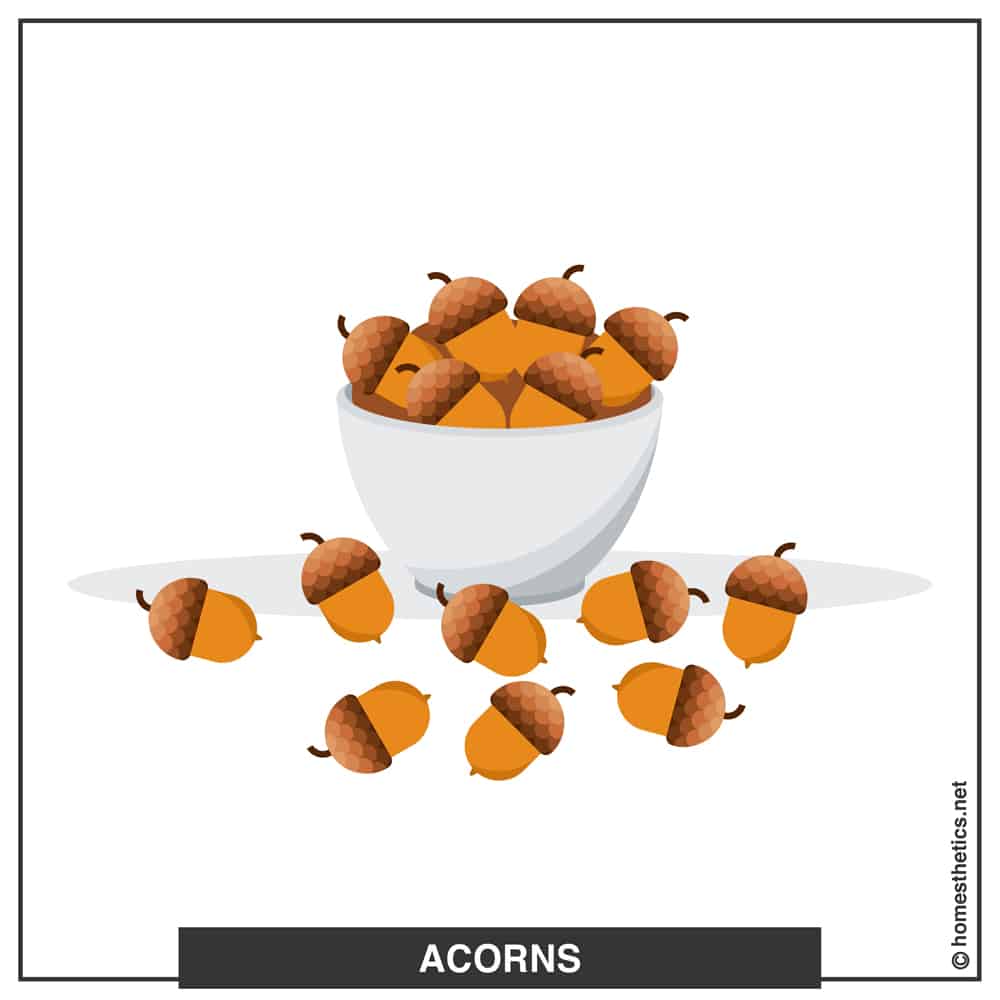
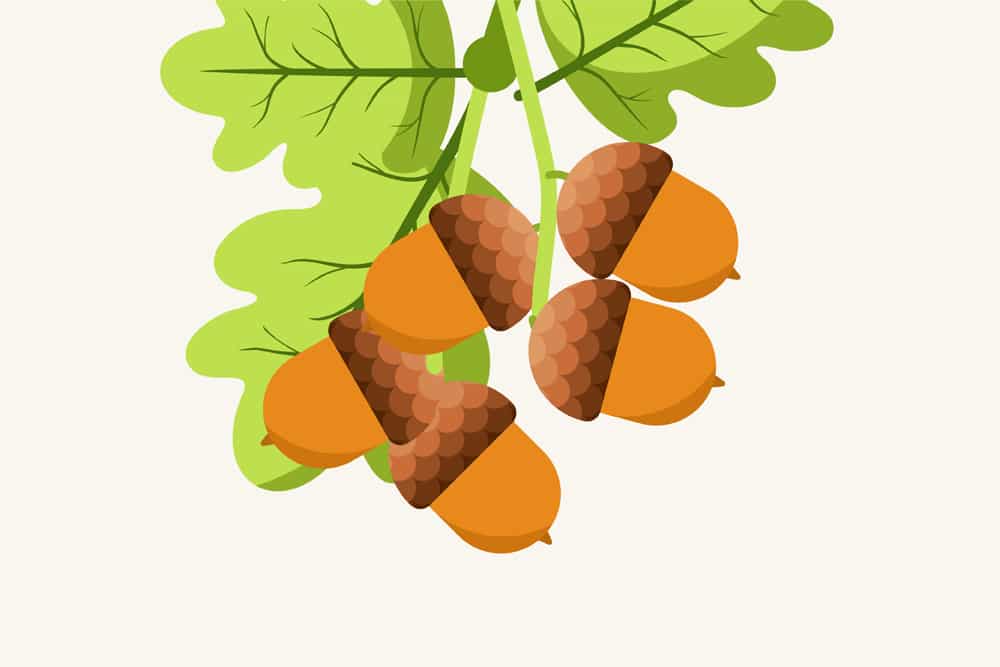
The edible nut comes from oak trees in the USA, Europe, Asia, and Northern Africa. For making acorns fit for eating, they must be treated for tannic acid, which can have toxic effects on humans. A repeated drying and boiling procedure is used in this treatment.
These nuts also have an interesting background, as studies have shown them to be historically significant as a staple in North American and Indian diets. These nuts can also be roasted for consumption and contain a whole lot of essential nutrients.
Acorns are high in potassium, vitamins A and E, iron, and various other important minerals. Added to this, they are low in calories, making them a great fit for weight loss diets. Having these nuts included in the diet also boosts energy levels.
After Acorns have been treated to remove the tannins, they can be used in several recipes as a taste enhancer. Some common meals where acorns can be used are porridge, acorn flatbread, and acorn flour honey cake.
-
Sunflower Seeds


Technically, they are fruits of the sunflower plant from North America and are harvested from the plant’s large flower heads. Due to their firm but tender texture and mildly nutty flavor, sunflower seeds have similar culinary uses as nuts. Currently, they are also grown in Ukraine and Russia.
A single sunflower might contain as many as 2000 seeds. The sunflower crop has two varieties- while one is grown for edible seeds, the other is used to extract the oil. The seed which is consumed is enclosed in black-and-white striped shells known as hulls.
Sunflower seeds are highly beneficial in reducing chronic inflammation that is linked to an increase in the risk of heart disease. Apart from this, they help to lower blood pressure and blood sugar due to the presence of Vitamin E, magnesium, protein, and fatty acids.

Similar to nuts, roasting sunflower seeds enhances their flavor. The seeds are popular as a stand-alone snack and can also be used as toppings for salad and yogurt.
-
Pumpkin Seeds
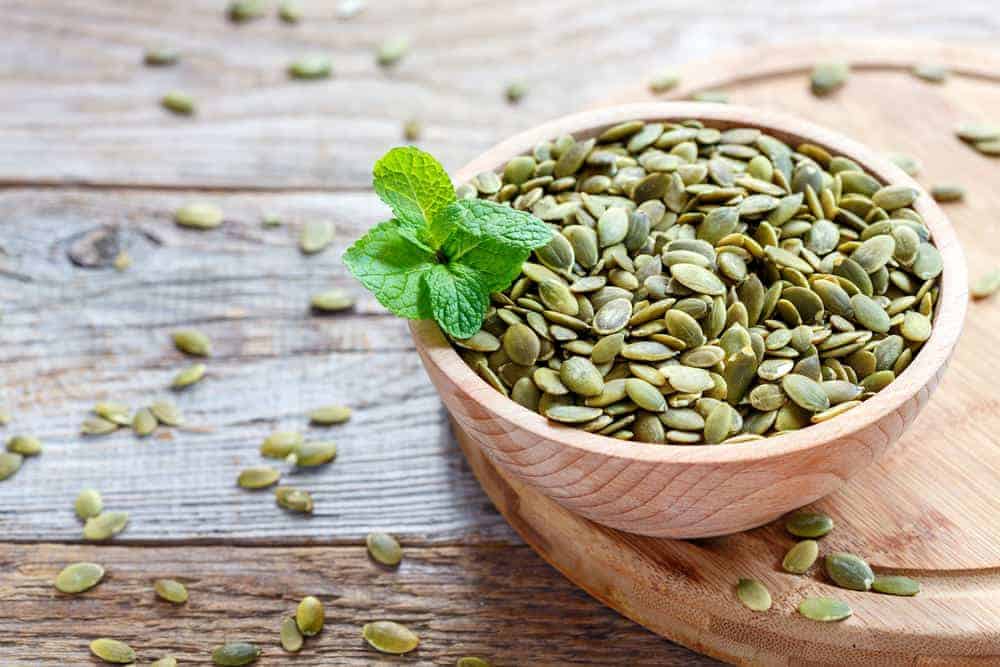

These seeds are obtained from the pumpkin plant found growing in countries such as the United States, India, Egypt, and China. To prepare pumpkin seeds for consumption, they need to be gathered from the meat of the fruit and washed off.
The seeds can be eaten in their raw form or maybe roasted for a greater flavor. They are a popular snack item across different regions of the world.
Pumpkin seeds are quite small in size, but don’t go by that! They are little powerhouses of nutrients, with a number of health benefits. With a high protein and unsaturated fat content, the seeds can be a perfect companion throughout your weight-loss journey.
Pumpkin seeds are also helpful in preventing complications in diabetic patients by keeping cholesterol and blood sugar levels under control. Being higher in fat content in comparison with many nuts, they are also commonly used in oils and butter.
-
Cacao
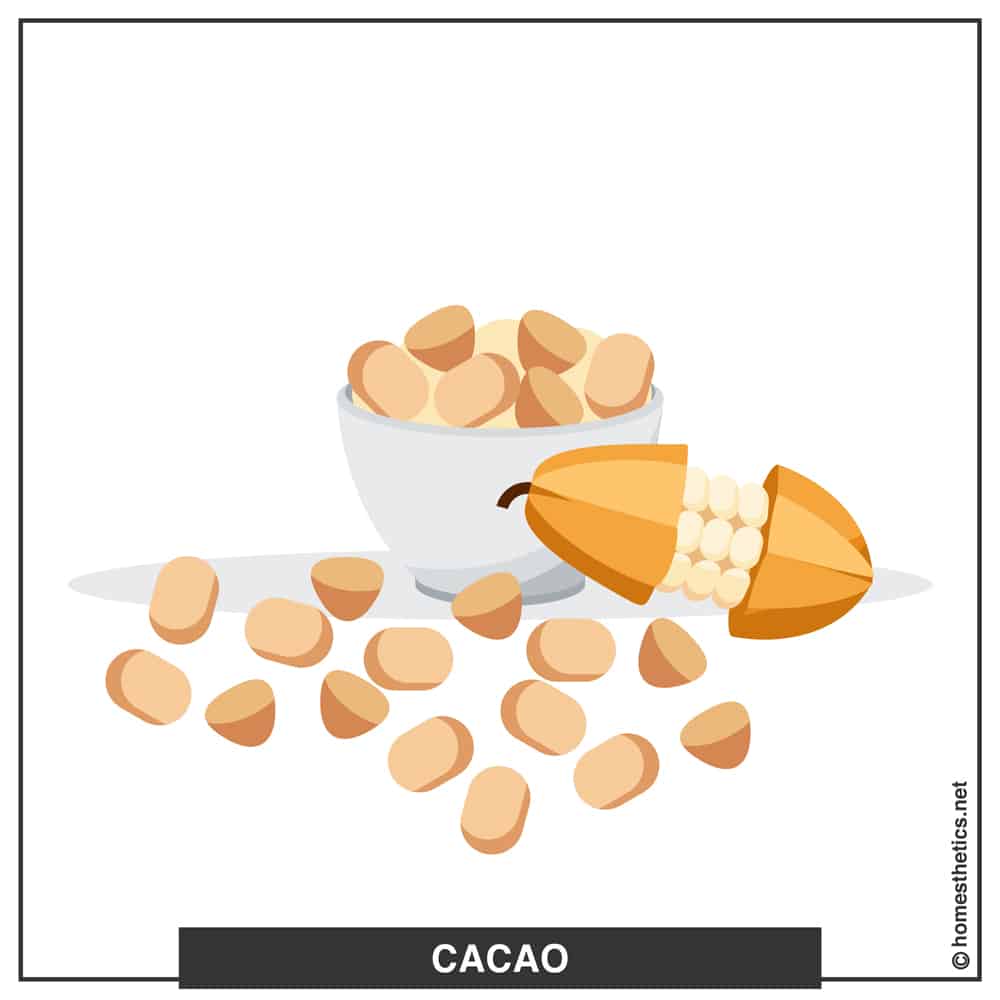

Popularly referred to as cocoa beans, these seeds grow in the lowland rain forests of the Amazon and tropical areas of Asia, among other regions.
The bean pods of cocoa are harvested after they ripen, and the seeds are extracted after a ten days drying period. This is not the end of the processing, as they are fermented and dried again to make them ready for eating.
Cacao seeds are highly rich in flavonoids that help to lower blood pressure and improve the flow of blood to the brain and heart. The fiber present in them facilitates proper digestion and antioxidants reduce inflammation as well.
The seeds are not consumed as a snack on their own but are an important ingredient in some very popular sweet dishes. A few tablespoons of cacao powder are integral to that magical taste of a chocolate smoothie. Similarly, the gluten-free raw brownies that vegans love are prepared using cocoa beans.
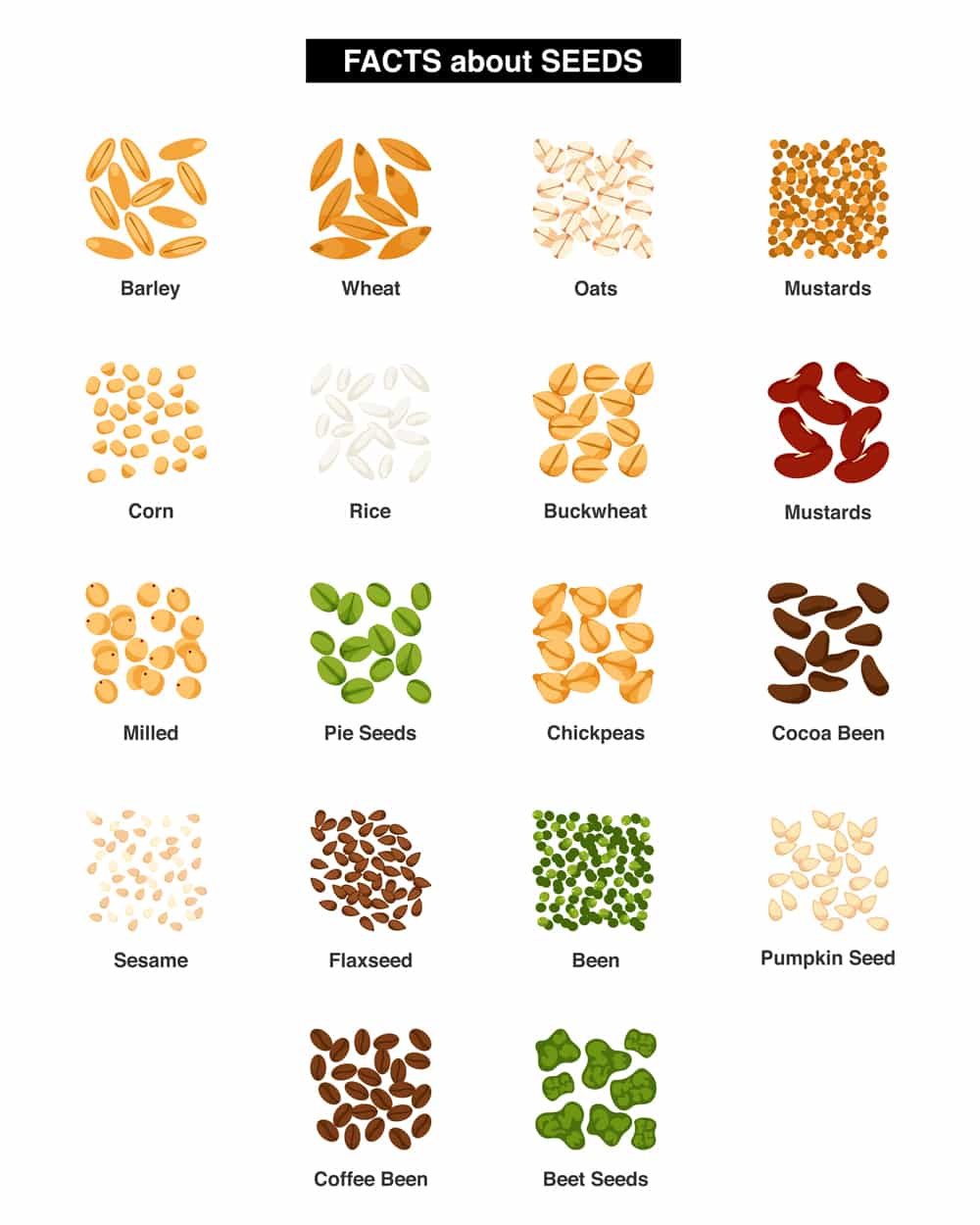


Types Of Nuts Conclusion
Isn’t it marvelous how different types of nuts come with such a varied range of health benefits? Add to this the various tastes and flavors, and they could very well be considered the superheroes of the food world!
Certain fats common in nuts, such as mono and polyunsaturated fats, can aid in weight loss and reduce the risk of cardiovascular diseases. This is contrary to the popular belief that nuts are high in calories and fat.
You can add any one of these nuts as your evening snack or include it in the breakfast diet. After all, their beneficial effects can be maximized with minimal processing, so you don’t have to put in a lot of effort to consume them.
So, go ahead and select the one that you would prefer!

